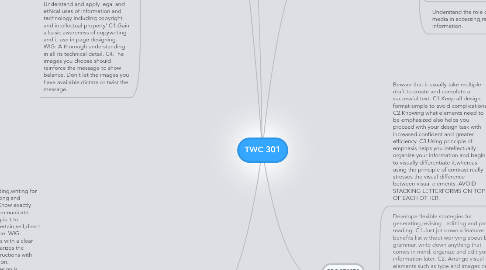TWC 301
by freda yamoah

1. RHET0RICAL KNOWLEDGE
1.1. Identify,articulate and focus on a defined purpose
1.2. Respond to the need of the appropriate audience
1.3. Respond to appropriate rhetorical situation.
1.4. Use convention of format and structure appropraite to the rhetorical situation. C1. The kind of page format(size,shape and function of the page) you want your audience to view on.
1.5. Adopt appropraite voice tone and formality.
1.6. Write in multiple genres
1.7. Understand the role of variety of technologies / media in accessing,retriving and communicating information.
2. PROCESSES
2.1. Beware that it usually take multiple draft to create and complete a successful text. C1.Keep all design format simple to avoid complications. C2.Knowing what elements need to be emphasized also helps you proceed with your design task with increased confident and greater efficiency. C3.Using principle of emphasis helps you intellectually organize your information and begin to visually differentiate it,whereas using the principle of contrast really stresses the visual difference between visual elements. AVOID STACKING LETTERFORMS ON TOP OF EACH OTHER.
2.2. Develope flexible strategies for generating,revising , editting and proof reading. C1.Just jot down a features and benefits list without worrying about better grammar. write down anything that comes in mind. organize and edit your information later. C2. Arrange visual elements such as type and images on the page according to their order of importance and,consequently,emphasis.C4. Adding a drop shadow behind an element adds a dimensional look.Skewing elements away from horizontal and vertical adds dynamic energy to a layout. C7. Knowing who your audience is will help construct a document with better flow.
2.3. Understand the collaborative and social aspects of research and writing process.COPYRIGHT,FAIRUSE AND CREATIVE COMMONS:Always cite your sources when using a copyright material.
2.4. Use appropraite technologies to manage data and information.C5.Consider creating a grid structure for any multiple page project that you may work on again in the future.Grids enhances design consistency.C7.
3. KNOWLEDGE OF CONVENTIONS
3.1. Learn common format for different genre. CI. Six guidelines to design principles are emphasis,contrast,balance,alignment,repitition and flow.C2.Emphasis states the most important element on the page that should be most prominent. Placing elements in the optical center of a page emphasizes them. C4. A page designer can achieve balance through either symmetrical or asymmetrical layout.Symmetrical balanced layout is one in which visual elements are mirrored from side to side from top to bottom, and asymmetrical balanced layout, the words and phrases and graphics are arranged unequally on either side of the imarginary axis still focusing on a harmonious balance.
3.2. Develope knowledge of genre convention,ranging from structure and paragraphing to tone and mechanic. WIG:At the beginning to write a project instructions, it is important to determine the structure and characteristics of the particular procedure you are going to write about.
3.3. Understand and apply legal and ethical uses of information and technology including copyright and intellectual property' C1.Gain a basic awareness of copywriting and it use in page designing. WIG: A thorough understanding in all its technical detail. C4.The images you choose should reinforce the message to show balance. Don't let the images you have available dictate or twist the message.
4. CRITICAL THINKING,READING AND WRITING
4.1. Use information,reading,writing for inquiry,learning thinking and communicating C1.Know exactly whay you want to communicate and what is intent.eg.is it to persuade,inform,entertain,sell,direct or serve as experience. WIG: Prefix the instructions with a clear headings that summarizes the task. Do not mix instructions with conceptual information. C6.Consistency in design is desirable, especially in multiple-page documents, because a consistent,well-organized design makes reader more comfortable with the page and your communication will be sent well.C7. Organization, simplicity, clarity, and flow are critical to good design.
4.2. Integrate previously held beliefs assumptions and knowledge with new information and ideas of others to accomplish a specific purpose within a context.WIG: write for your audience and use a level of detail that is suitable to their skill level. C3.Don't be afraid to use strong contrast is one of the quickest and most effective ways to attract attention to your page and to visually organize the information.C5.Dont forget to place captions near visuals such as illustrations and other graphics.Most people look at visuals and their captions before reading body copy.C7. Choose an easy to read serif typeface such as Garamond and use it consistently through an article and also place headlines near their articles.
5. GOAL
5.1. To learn how to design flyer,invitation and become familiar with the design process.


